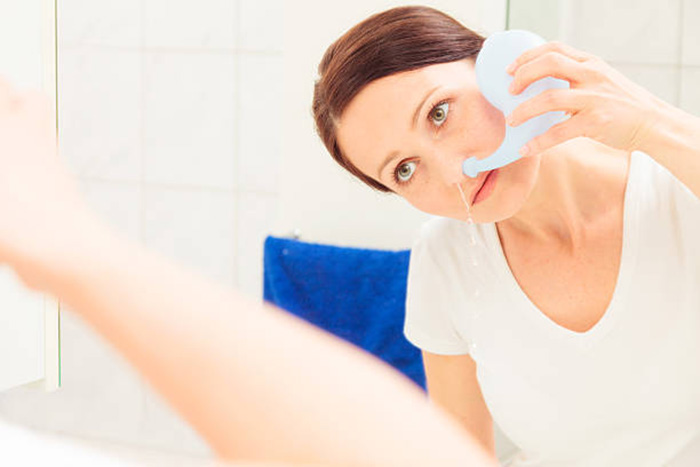
Published on March 28, 2022
Read Time: Three Minutes
Do you have a stuffy or clogged nose from allergies or sinus problems? Many people are turning to nasal saline irrigation methods (such as a neti pot or sinus rinses) for relief.
Mary Doellman, DO, an ENT (ear, nose and throat) and allergy specialist at Phelps Health, answers common questions about neti pots and sinus rinses as well as offers recommendations on when and how to use them.
What is nasal saline irrigation?
Nasal saline irrigation is a remedy to help relieve nasal congestion, clear thick mucus and remove viral or bacterial infections. This treatment can be used to reduce nasal swelling, a runny nose or mucus from allergies and viruses.
What are the types of nasal saline irrigation?
A common type of nasal saline irrigation is a neti pot, which is shaped like a teapot that contains a saline solution (salt water). You place the neti pot spout into one of your nostrils and tilt your head to the side. The saline solution flows out of the neti pot and through your nasal cavity and out the other nostril.
Most ENT providers prefer the NeilMed sinus rinse, an 8-ounce squeeze bottle with a tube at the end. With this sinus rinse, you lean your head forward and squeeze the bottle, which causes the saline solution in the bottle to go up your nostril. The solution goes to the back of your nose (nasopharynx) and comes out your other nostril.
Neti pots and saline rinses are different than nasal sprays.
What type of water or solution should I use?
Use previously boiled or distilled water that is mildly warm. Tap water, and especially well water, have natural bacteria or amoebas that could give you an infection.
Who can use a neti pot or nasal rinse?
Infants through adults can use the NeilMed sinus rinses. If your child can hold up their own head, they can try it. Nasal saline irrigation should not be used on newborns.
Are neti pots and nasal rinses natural remedies?
Yes. Since they use saline, and nobody is allergic to saline, nasal rinses do not interact with other medicines. The saline solution rinses out any particles that are causing the allergic swelling in your nose. These rinses can stop the allergic reaction from continuing and decrease swelling and drainage.
How often should I use a neti pot or nasal rinse?
Use a nasal rinse as often as you need, whether it be a few days or once a week. When your allergies are bad, you can use a neti pot or nasal rinse one to two times per day. Many sinus surgery patients may need a sinus rinse up to six times a day for a short time.
What are the benefits of using a neti pot or nasal rinse?
Neti pots and nasal rinses can help break up and drain mucus and rinse away allergens in your nose that are causing you to be congested. These treatments are natural, easy-to-use and highly effective. Nasal rinses also may help prevent sinus infections, headaches and worsening allergy symptoms.
How should I clean my neti pot or sinus rinse bottle?
Manufacturers strongly recommend you handwash and thoroughly dry nasal irrigation products after every use. For your product’s specific cleaning recommendations, refer to the instruction manual or website. While sinus rinse bottles and neti pots are often dishwasher safe, a dishwasher will not adequately clean them. A dishwasher’s water jets cannot enter the neck of the bottle/spout of the pot, so portions of the product’s interior may not get cleaned thoroughly. Finally, instructions say to get a new neti pot or sinus rinse bottle every 3 months.
Where can I get a neti pot or nasal sinus rinse?
Many pharmacies carry neti pots and sinus rinses, or you can order them online.
Suffering From Sinus Problems?
Learn more about allergy and ENT (ear, nose and throat) care at Phelps Health or call (573) 364-5719